The very humanitarian crisis in Syria and recent violence in Paris are embedded in it. It stems from dominant concepts of identity, politics, freedom, economy, technology, and art.

No Part of a Society is Separate
Sterilized geese, a fertilized monoculture , and invasive lake weed mowing, to create an image of human paradise on the shores of Okanagan Lake.This activity comes from the same root as university education.
I don’t mean to slam universities, just that the problem is here among all of us, embraced by most if not all of us, and is connected directly to the strengths of our cultures. This makes it a classic tragic flaw.
To refresh your memory:
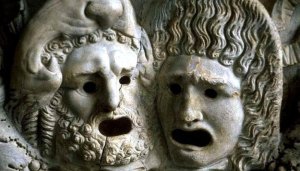 Tragic Flaw: that which makes one great is that which destroys one. It is a dual gift-and-curse from one’s ancestors. It is inescapable, but how one meets it is what makes a person human.
Tragic Flaw: that which makes one great is that which destroys one. It is a dual gift-and-curse from one’s ancestors. It is inescapable, but how one meets it is what makes a person human.
With your indulgence, I will try to explain. When I wrote a few days ago that this kind of thing …

South Cariboo Aspens in September
… was a human habitat, viewable and readable best by human presence, it’s good to keep in mind that I am not alone. Here’s how Peter Kulchyski puts his relationship to this kind of landscape in his presentation “bush manifesto”:
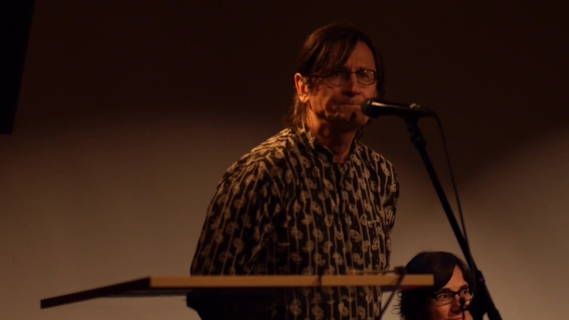
Click on this link to watch the video: http://tinyurl.com/pk7rxe8
In fairness, this discussion should include mention that this kind of thing …
… is not a human habitat. It is, however, a representation of the human body and of power. It is certainly not neutral. It is a machine. It has costs that go along with the powerful extensions it makes of human bodily and social space. It also doesn’t spring from nowhere, but is the representative of certain cultural traditions. Such as this:

Beltway 10 Exit, Houston, Texas
Such as this:

Gun Shop Display in Idaho
Such as this:

The pistols and automobiles and phones I showed you above are forms of communication that cross certain physical-cognitive barriers. So is driving on a freeway, which moves packets of identity and observation here and there, physically. They are all expressions of individual identity and are all disruptive of terrestrial environments. We should not forget the lessons of this man …
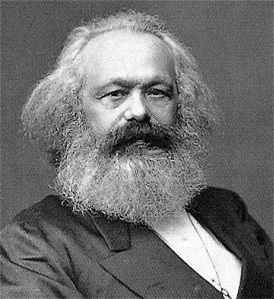
Karl Marx
… who analyzed brilliantly that the capitalism of the Industrial Revolution had created two new classes of people, who lived their lives within the boundaries of the forces of capital: the proletariat, largely the dispossessed, working class (when they could get work) of inner cities, the people who had nothing but their selves and sold their life energy to sustain capital and the machines that were its image; and the bourgeois, who accumulated the energy of the proletariat by harnessing them to machines, and became rich on the excess energy that flowed to them, which, in the terms preferred by capital, is also called “profiting from risk,” which is termed a heroic good. Here’s an example of a proletariat man, my grandfather, Bruno Leipe, who came to Canada from Silesia in 1929:
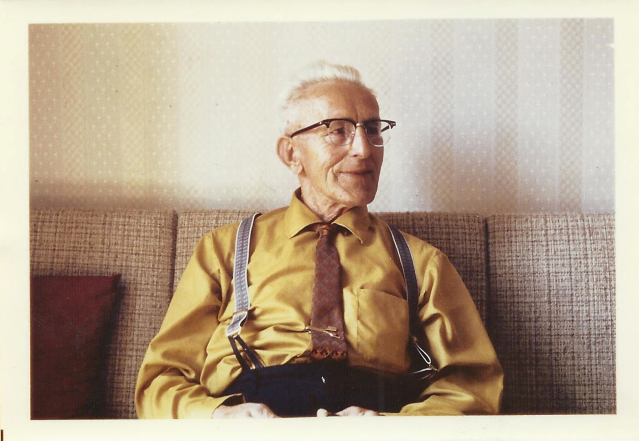
The image was taken forty-six years ago. He had two years left with us. Here’s an example of a bourgeois woman and her child in today’s Gleiwice, in the year when my Grandfather Bruno (above) was born a few kilometres way in today’s Wroclaw.
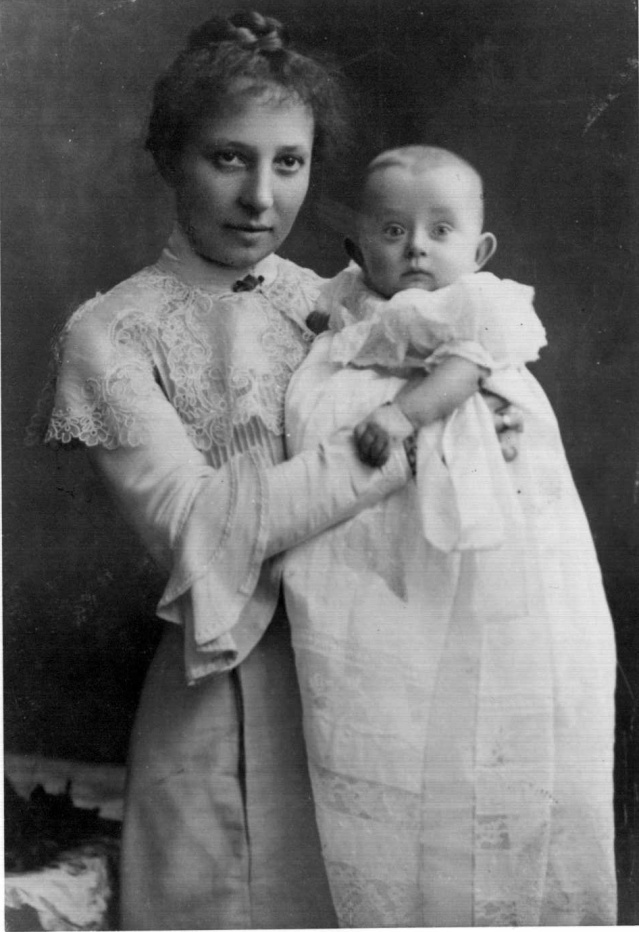
This is Emilie (Winkler) Rhenisch and her son Johannes, or Hans (my other grandfather), on his Christening Day in 1900. The teenage and productive adult lives of these two grandfathers, Bruno and Hans, were caught up in the designs of capital, which Marx so clearly described, in a struggle between capital, men and machines which is known today as the (First and Second) World War. What is missing today is another Marx, to decode the classifications of persons created by post-industrial capital.
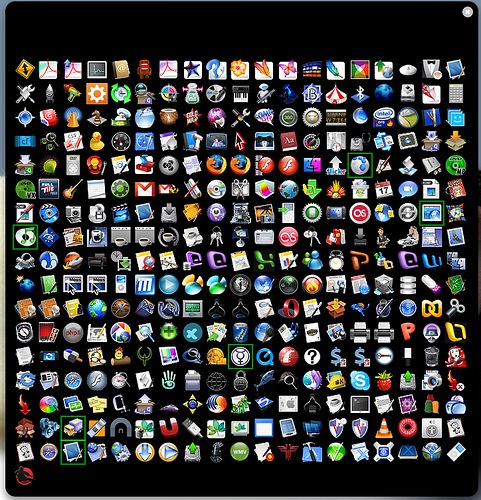
App Happy: The Physical Manifestation of Post Industrial Capital & American Political Models
Use at your own risk. Humans used to be able to do most of this stuff.
Make no mistake. This attractive (i.e. magnetic or alluring) stuff comes with a cost. Few of us outside of the United States would be willing to accept U.S. military invasion and occupation of our countries (and few Americans would stand for it, either), yet the point of fusion between American culture, American politics and post-national and post-industrial capital is currently embodied in a series of electronic tools, which perform certain tasks, which are unquestionably embraced, and which form part of every user’s identity. They are still outposts of capitalist structures, though.
 Lumenplay iPhone App enabled Christmas Lights
Lumenplay iPhone App enabled Christmas Lights
In other words, human thought flows in the profit flow charts of global corporations, exporting one country’s thought patterns in the form of its technology. Western human life is increasingly lived in the street grid between these tasks, rather than in the earth, where human bodies are so much wiser and more capable than these tools, just not for the ends the tools are created for. A useful question would be: are the ends worth the costs?

Emilie Winkler Rhenisch’s Daughter-in-Law
Dr. Charlotte Koernig Rhenisch Hartlief. She was a beloved doctor who was given the keys to her city in appreciation of a lifetime of care, including the care of 18,000 patients for several years during the Second World War.
A few of my ancestors are showing up here, I know, but they should. I am a biological creature, and they are within me. I look at the world through their eyes almost as much as with my own. I had to work for that, as it’s not just biology, but that’s part of my point: humans work for things; they build ways of knowing which they then live within and even embody. Smartphones do, too, of course, as they are surrogate human bodies. Doubt it? Look.

The New Proletariat in China
Building iPhones. What is in control of whom? What is a whom when what is whom and whom is a what?
The earth is the one human habitat, yes, but just as I wouldn’t embody my ancestors fully without training, or wouldn’t fully embody my land …

Palouse Falls, the Living Heart of the Columbia Plateau
I live in the north, somewhere near the left eye.
… without exploring it continuously for years and learning its history it’s also true that without experience in the earth human bodies become dulled to the fullness of their capacities for reading the flow of energy through the physical world. In its place, they grow finely attuned to electronic webs (the embodied forms of capital which people must now navigate) as well as the first generation of industrial capitalist habitats, urban street patterns.

Your Blood Vessel Today
Ultimately, the position arrived at is a compromise: social universality. In it, all social avenues are equal and good, because all are individually chosen by people as they navigate the webs that hold them. True enough, but there is a universality not covered by this approach, and it looks like the image below:
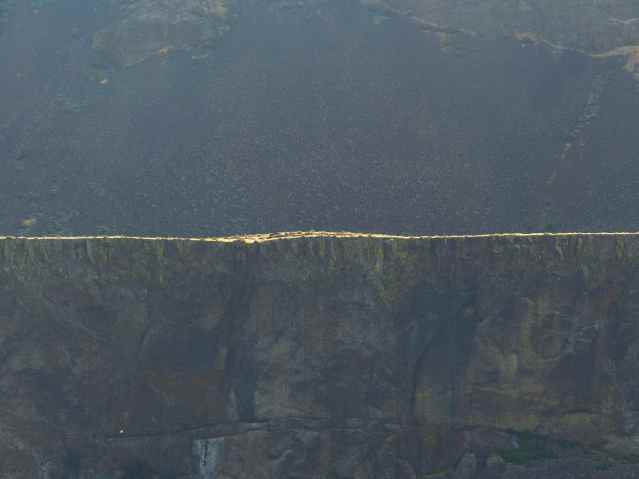
Lake Lenore Cliffs, Washington: The Heart of the Sinkiuse Illahie
The earth is not relative. Calling it the “other” or “nature” or otherwise excluding it from the human social (ie. bodily) sphere doesn’t change that. It just delays recognition. Social arguments don’t help, either. The quest to create Apps to fill the gap between romantic individual identity, the earth, and social and biological identity …

… remains Quixotic, because every app widens the gap, no matter how useful or even frivolous (and perhaps fun) it may be. Whatever the apps are, they shut down one set of human abilities, while opening a set of human-machine interfaces, interfaced with social identities mediated by algorithms. It doesn’t matter how you spin it. One of the consequences of this ever-regenerating gap is quite profound. Instead of the following as a model for the flow of thought, for example …

A Moss World
Instead of soil, these wild flowers have rooted in the matrix of space that is the moss: warm, wet, full of nutrients dissolved from the rock and absorbed from falling dust, stable, and open to the sun.
…, because of the mechanized culture of industrialization (social sculptural forms of capital), now present in the language of electronic machines, thought that can inhabit these patterns and extend them has largely atrophied. In its place we have poetry concerned with words themselves and with pure resistance, the last bastion of the physical body, in such manifestos as Michael Hofmann’s recent declaration quoted in Mary Ann Caws’ recent article Poetry Can Be Any Damn Thing it Wants in Poetry Magazine. (Note, in this argument, humans cannot be any damn thing they want, but are tethered to the wants of their language, or of the point at which language is generated out of biology.)

http://www.poetryfoundation.org/poetrymagazine/article/182834
In the place of thought inhabiting body memory in habitation of the world, thought becomes random violence like Hofmann’s above, or linear or statistical, like this:

… or this …
… or this representation of the late capitalist, bourgeois human body:

Notice how in this body image everything is a visual screen and a social communication, not with people but with the image or surface of people, cognitively encountered.

In My City, Vernon, the Skier and the Automobile are Both Driven
The earth in cities consisting of such isolated surrogate social bodies is groomed into a neutral aesthetic.

Leaf Blowers Taking a Rest
In such aesthetic landscapes, the body is a shelter that an identity cares for but is not united with. I say that because no body …
 … portrayed as a world full of eyes that broadcast images across space to human biological receptors (making the space of a house an analog of the distance between retina and brain) …
… portrayed as a world full of eyes that broadcast images across space to human biological receptors (making the space of a house an analog of the distance between retina and brain) …
 …in which each device, like the television screen above, broadcasts its identity (in this case, its corporate DNA) into the cognitive receptors of its biological inhabitant….
…in which each device, like the television screen above, broadcasts its identity (in this case, its corporate DNA) into the cognitive receptors of its biological inhabitant….  … can move with ease in the space recorded by the following image …
… can move with ease in the space recorded by the following image …
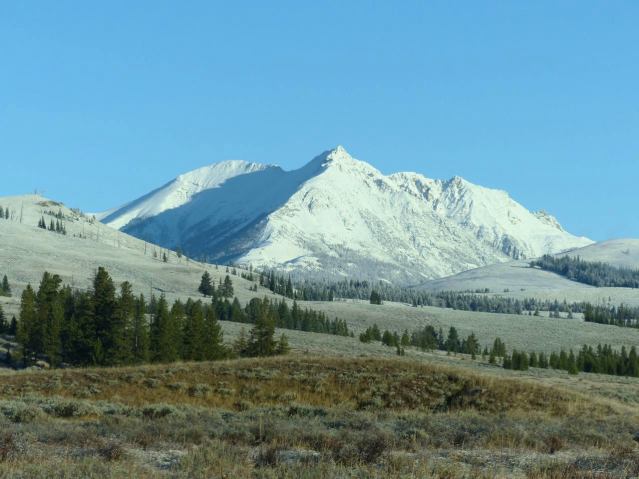 North West Yellowstone, September
North West Yellowstone, September
… (although they are expert at recreating its image with their digital eye-memories):
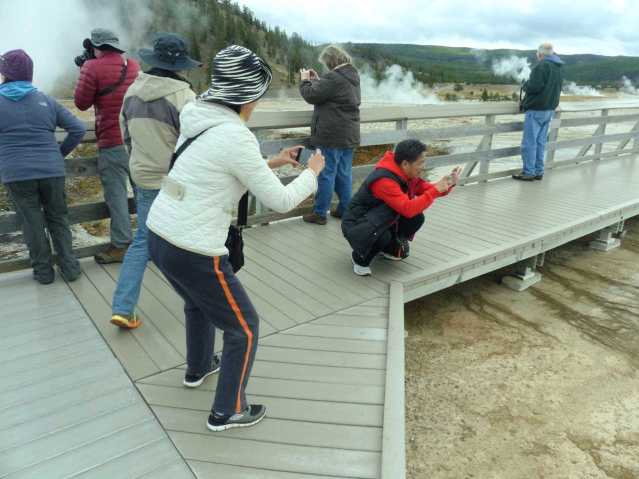
Middle Geyser Basin, Yellowstone
Cameras can be used for other ends, but it’s difficult to remain separate from the machine (as it is, after all, an image, that most seductive of objects to humans, and one that makes images, to boot. That can be like crack cocaine.)

Robin on the Wing
Certainly, a body alienated from the earth can still experience presence in space as beauty …
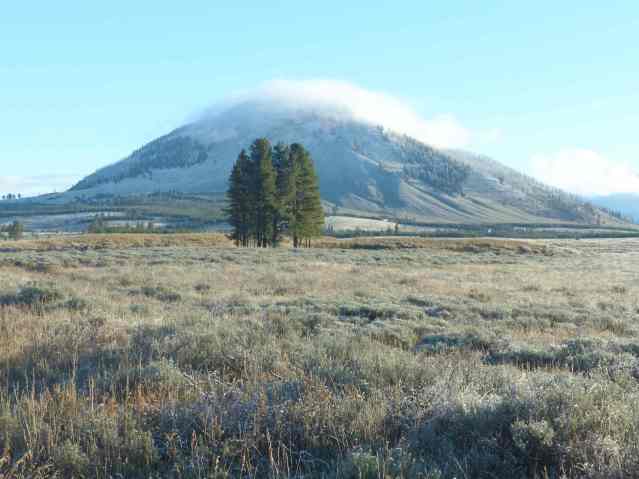
North West Yellowstone Morning, September
… but at that point it risks exhausting its repertoire. Understandably enough, it has little body memory in this space, with which to deeply read the earth’s complex, non-linear speech.

Big Bar Lake Wetland, Autumn (September 5)
That is all fine and good, of course, except that humans are the creatures who have control of the planet, and for two hundred years have been treating it with the subtlety that has reached its perfection in the image of the Smart Home above. That image is this mountain.
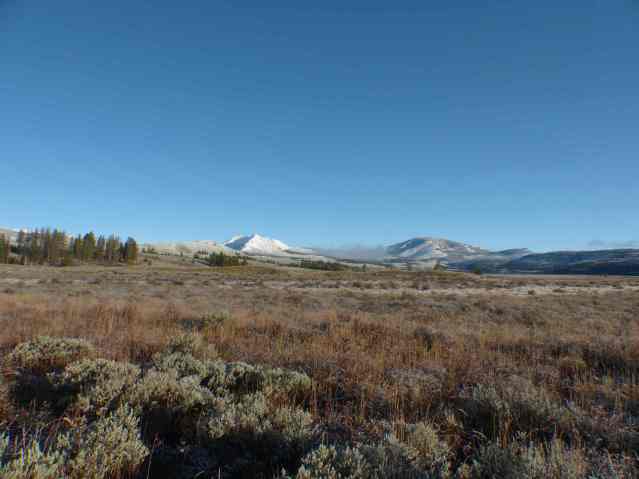
Northwest Yellowstone After Night’s Freezing Rain
For an image of the human body to go along with these body images, we now have gene sequences:
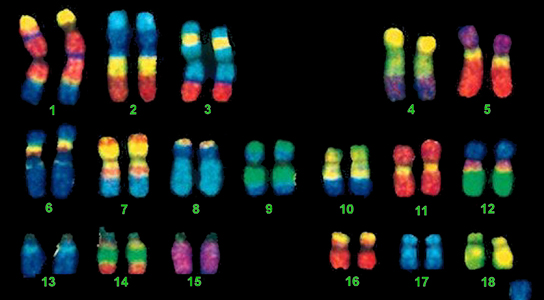 Human Chromosones
Human Chromosones
Again, powerful, and useful, but this approach does read bodies as if they were biological machines rather than spiritual, physical, organic, or social bodies, integrated with a genetic and social history. Compare the body image just above with the one just below:
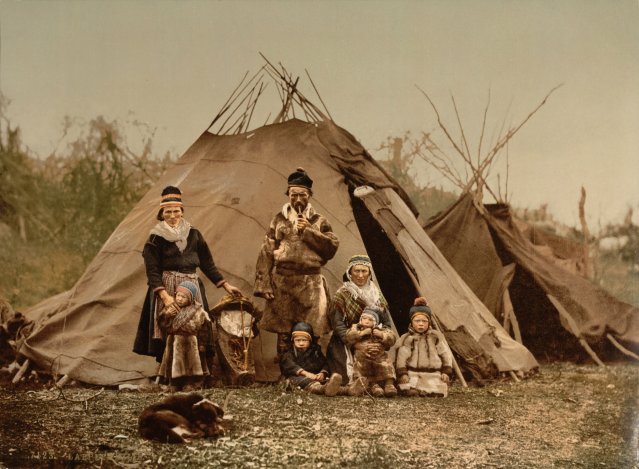
Sami Camp Back in the Day Source
The combination of this particularization of identity and its reading as particularized machine language also particularizes human identity, and makes human identity particularized. How could it not? How does this all fit with Syria, or with my country, the Okanagan, this valley of grass and strip malls in Cascadia?

Porcupine, Particularized
He knows.
For that, just a little bit of history — a kind of social genetics. I’ve been working on this material for months. Look at what it has done to me.
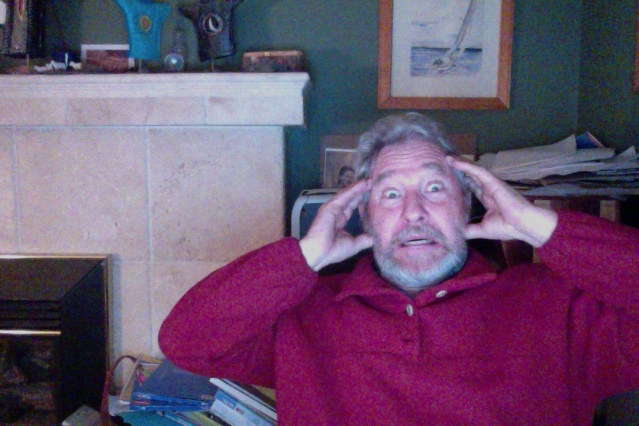
Unfortunately, my personal horror is not the point, but the formation of this country of mine was heavily influenced by men who kept slaves, or came from slave-keeping culture, and looked upon people racially, sorted them racially, and determined their social worth (to them) racially. Men like this:

Gabriel J. Rains
After botching an inflammatory assault by a vigilante army on the Yakama People in 1855, he went on to join the Confederacy and invented the anti-personnel mine.
A vigilante army of the period was made of men like this:
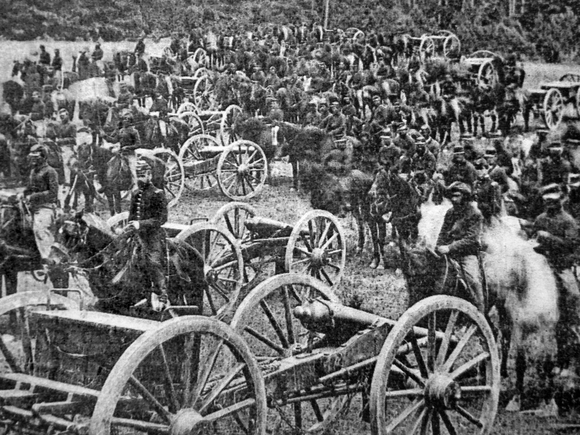
Rogue River War Volunteers, 1855, Southern Oregon
They ran amok, manipulated the government into paying exorbitant rates for them to form undisciplined, genocidal vigilante armies, and killed many thousands of indigenous people in order to force them into violence, which they then called upon the U.S. Army to quell. After all, a Liberal government in Washington could propose a humane and generous settlement for indigenous peoples, but if they were all dead before the treaties were signed or reservations were set aside, or if all the land to be set aside for them had already been stolen, then the law was moot, because individualism trumped it. Historians were little help:
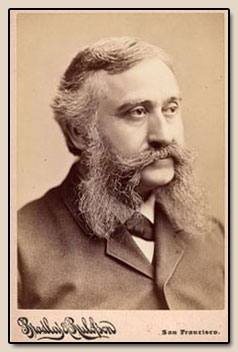 Hubert Howe Bancroft
Hubert Howe Bancroft
In his deeply researched 1884 volume, History of the Northwest Coast, he wrote:
“It has always seemed to me that the heaviest penalty the [French or French/Indigenous] servants of the Hudson’s Bay Company were obliged to pay for the wealth and authority advancement gave them was the [Indigenous] wives they were expected to marry and the progeny they should rear. What greater happiness to the father, what greater benefit to mankind than noble [White] children! I never could understand how such men as [Chief Factor, Dr.] John McLoughlin … and the rest could endure the thought of having their name and honors descend to a degenerate posterity.”
Set against these racialized and/or psychopathic men were a large population of decent, hard-working, law-abiding American immigrants to the North West (Oregon, Washington and Idaho, mostly), who were often Methodist, which is to say, largely believed that if all peoples on earth could align themselves with government, God and the existing social and Christian (non Catholic, non romantic and strongly authoritarian) order, and purify their bodies of discord, God would be manifest on earth in the entire community of men and women on Earth — a rather literal reading of the notion that the Church is the body of Christ, but beautiful nonetheless. However, obedience was all, and the fitting of human identity into very hierarchical rules, to which only some people, because of their skin colour, had access, was, really, little different, from a global perspective, than the slave culture of the American South, which was built on discipline, individual, romantic and emotional embodiment of absolute power (called reason), and ownership of vast tracts of land, under the labour of thousands, for the profit of one. People like the ones in the following image were hunted like rats.
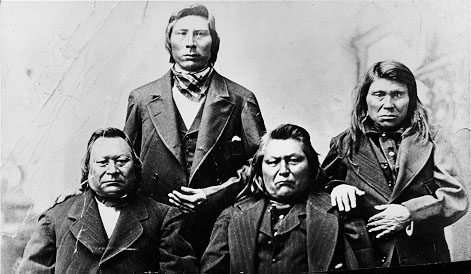
1879 Delegation of Plateau Chiefs to Washington D.C., pleading for a Reservation on the Columbia River, their Ancestral Home.
Left to Right: Sulktalthscosum, Chilileetsah, Hiachenie, Homily.
The last vigilante attempt to force their slaughter (specifically, in this case, of Sulktalthscosum and Chilileetsah and their families) by volunteer militias attached to the U.S. Army took place in 1893 … 46 years after the vigilantes started this deadly game of terror. It took the Army that long to gain the political power to withstand this manipulation. That manipulation is happening in France today.

Abdel Hamid Abaaoud
Taunting France, before he started shooting in Paris.
At the core of this manipulation lies a conflict between individualism and collectivism, which is again being debated with murderous violence and racism. Here’s the newly ascendant face of ultra conservative France.

Marine LE PEN lors d’un rassemblement du FN sur la place du Palais Royal. Paris le 14/11/2005.Photo Paul Delort / Le Figaro
I expect French and European security forces will master this difficulty in time, but it remains telling that a primary form of terrorism active today is through images displayed in surrogate human bodies, called cell phones, which provide conduits for bringing any kind of violence right into personal homes, and, farther, into human souls and deep, subrational bodily responses. In the hands of IS, cell phones are guns. They trade faster than cars.

All electronically enabled people are socially present in these visual acts, as they struggle to remain human within streets and alleys of these images of pure, irrational force. Given that the proletariat and the bourgeois came out of industrial cities and the flows of capital and power their buildings represented, it’s unlikely that these new virtual cities, in which most people in the West live today, will not create new classes of people, representing these new forms, as people diverge from commonality to meet their power structures based upon their individual positions to them. It could be that we’re already seeing a new proletariat, and like the poetics of John Hofmann, its enemy is bodies. At the very least, humans are changing to meet their technologies, dropping off sets of abilities to interact with the earth in favour of ones to interact socially with each other. These developments take place within a belief in the inviolate, independent individual, who can pick up any technology with impunity, use it, put it down, and not be changed by it; and a plethora of training schools for training people in technologies which are used in this way, bound to capital, including cell phones, whatever technology you are reading this on and I am piecing it together on, art, software, populist politics, Taylor Swift, language poetry, whatever. How could it be otherwise? This is the culture of this time. Here is an image of one of the first people to describe the issue:
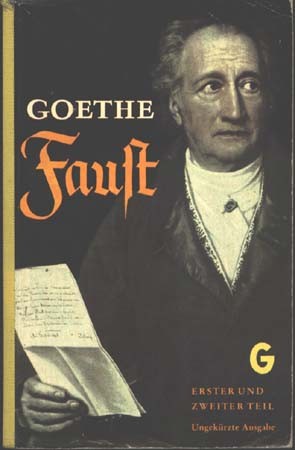
Johann Wolfgang Goethe, author of Faust.
Here is another:

Mary Wolstonecroft Shelley, author of Frankenstein.
Goethe argued that creating a science which particularized (individualized) information in order to understand it, and used machines, tools or devices to split up unified phenomena so they could be studied as minute individual forces (the powerful science we have today) was actually incomplete, as what would be observed would only be what could be observed through the machine, tool or device interface. Shelley created Frankenstein’s monster, who was an artifice of science, living but not human, and demanding rights as an equal. The questions they have posed are still active. One that must be asked concerning Shelley is that if an artifice, Frankenstein’s monster, can hold the rights of a human, why on earth can’t a raven?

Or an alder tree?

One question that must be asked concerning Goethe is that if the human body does have the capacity to absorb, manipulate and embody vastly different information than a device, and if it is capable of viewing unities instead of particularities, what is the methodical, refined process that would bring vital information into society, not as a replacement for science, god forbid, but as a parallel stream? Where would it take us environmentally, socially and politically that a digital (particularized and capitalized in all senses) future won’t? That’s murky …
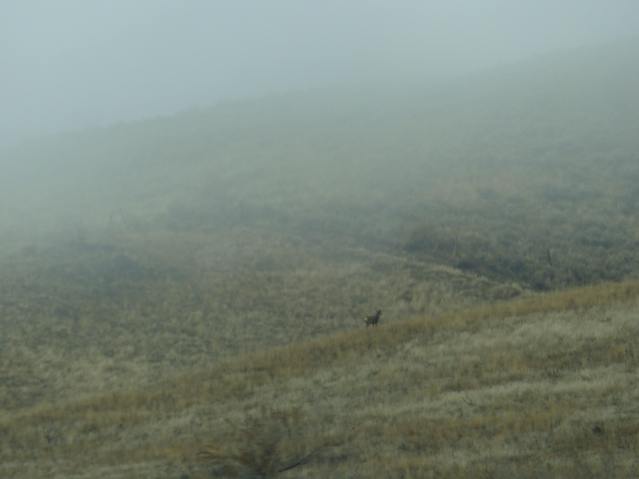
… but given the state of the earth today …

Northern Alberta Oil Country
… it is vital that humans find out. It might help. An unrelieved and unrelenting monoculture of digitalization is, after all, no more healthy than any other monoculture. In his book One Cubic Foot, for example, David Liitschwager talks about going to the cornfields of Iowa and attempting to measure the life forms existing in one cubic metre. As shown in a U.S. National Public Radio show and article, Cornstalks Everywhere But Nothing Else, Not Even A Bee, he tried it in a public park in South Africa. After 24 hours, he got this:
When he tried it in a cornfield in Iowa, the corn basket of the United States, where 100 years ago one could find 300 species of birds, 60 species of mammals, and many hundreds species of insects and plants, he found one species: corn. 45% of that corn is used for this:

This is called “green”.
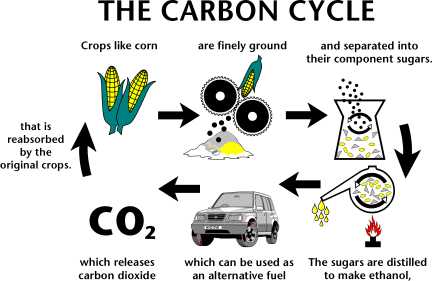
It is a profound mockery of ecosystems, natural earth cycles, human digestion, and humanity itself. If this is modern scientific technology and earth engineering, it is more primitive than this:
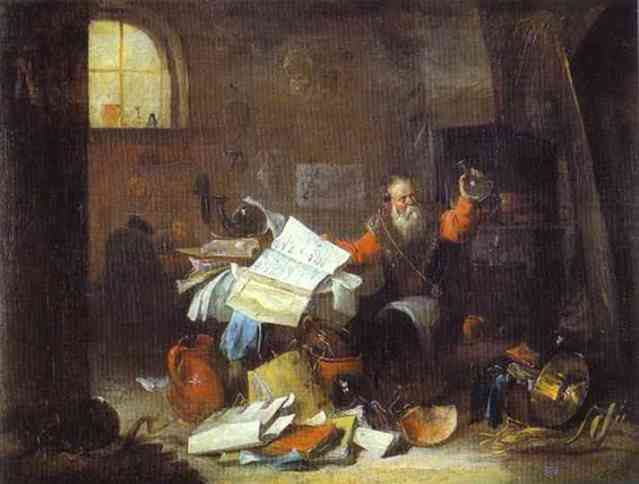 The Alchemist, David Teniers the Younger
The Alchemist, David Teniers the Younger
While corn produces fuel for automobiles, people go hungry. Sure, the reasons are complex: the desire in the United States to maintain industrial capacity, economic activity and infrastructure by keeping the cost of fuel low and to increase military independence by decreasing fuel imports, all to preserve U.S. individuality, embodied (and financed) largely in (and by) digital technology now. Whatever the difficult compromises and arguable social goods to come from them, this is a profound dehumanization. And Goethe predicted it in his book Faust.

Mephistopheles (The Devil’s Sales Rep) and Faust, holding a humunculus.
A homunculus is a “little man”, an artificial alchemical (early scientific) creation in which alchemists (like Faust) attempt to create humans and usurp God (the unified world that Goethe emphasized exists outside of science’s procedures for particularizing it.) Mary Shelley used it as a model for Frankenstein. Goethe would have had three other things in mind. First, the creation of the individual “I” (out of a self anchored in society, nature and spirituality, which did not have boundaries but had relationships which were muddily and usually politically defined and needed some straightening out) as a central anchor point for scientific thought by Johann Gottlieb Fichte at the University of Jena in 1792…
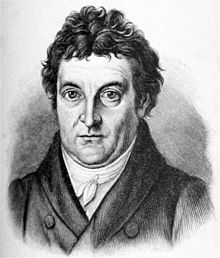
Johann Gottlieb Fichte
… which was shortly taken up by the romantics and converted into this kind of thing …

Taylor Swift Embodying the Scientific “I” as an Emotional Self
Second, the creation of the individual surrogate selves in fiction (which Goethe pretty much invented in German) and their ability to divert human attention from work in the world.
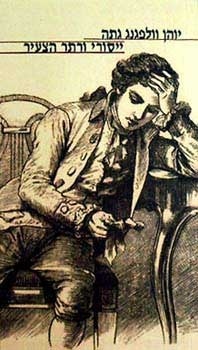
Goethe’s Sorrows of Young Werther in Hebrew
Third, Goethe had sold himself as a homunculus to Karl August, Duke of Sachsen-Weimar-Eisenach, to administrate his state, at great personal cost. Goethe was nowhere a perfect man (he was terrible to his sister, for one thing, and to friends and lovers of his wayward youth), but this was the assessment of the man who, next to Napoleon, was the World’s first superstar and was used as a poster boy for the aspirations of the ultra-conservative German right for a German state. He was seen as a genius, not a man, and, literally, the soul of his age. Goethe was warning us all: Don’t go there; quite literally you will be turned to stone.
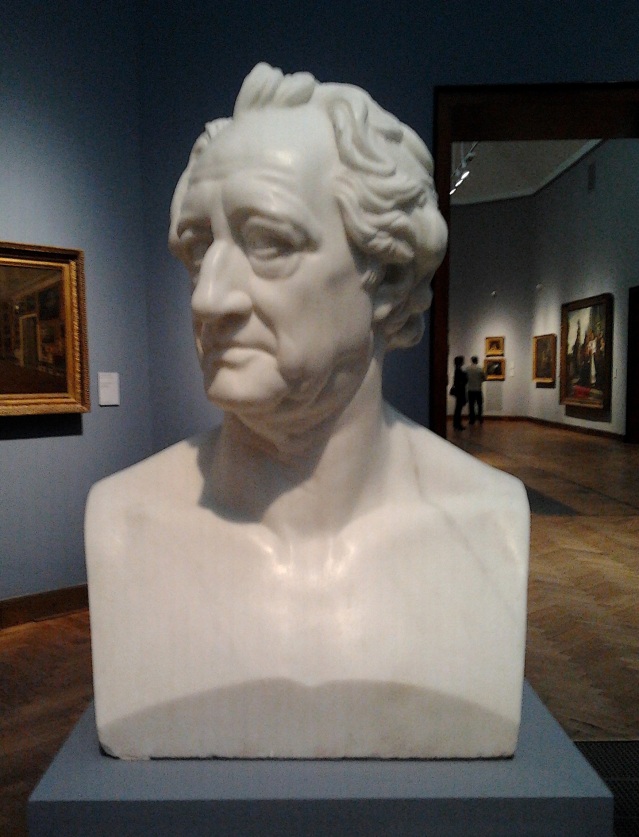
Goethe’s Death Mask Worked Up into a Bust Source
In other words, the ongoing Middle East disaster is not an accident. It is not the creation of fanatics and people who have lost their marbles completely but of cultural forces which have enslaved people and turned them into automata — machines, if you like, although curious, complex virtual ones with a highly romantic streak. They are acting in a play, a deadly play, in which human life is nothing.

Here’s another place in which human life was nothing:

Infirmary, Buchenwald
In front of this building of death stood the oak tree under which Goethe, the young poet, composed the first scene of Faust one day. The Nazis created this concentration camp to imprison the tree, and to imprison the politicians of the state built upon Goethe’s ideas, in a mockery, a miniature humunculus-like artificial state. The target of the terror embodied here was souls, first, and then bodies. This oak tree was usually decorated with men who had just been hanged.
The reason that Western literature is flush with the impossible creatures, the living dead, called zombies…

…is because zombies (straight out of Frankenstein territory) are real. Human self identities were always in an in-between state. The death camps of World War II Germany had far to many of the living dead, for another thing, soulless men waiting for their bodies to die. This horrific situation came to pass because official German society had stripped the term “human” from all but a few people, namely men who could prove that for the five generations since the defeat of Germany by Napoleon in 1806 their family had been “German” — 3,500,000 of them by the end of the Second World War, out of a population of 80,000,000. These men viewed the world, including economics, art, philosophy, science, and so forth, as a series of racial expressions. My grandfather Dr. Hans Rhenisch (a Front Line surgeon on the Eastern Front) was one of them. I’m not happy about that. This, however, is what I am more ashamed of as a North American:
 What a degradation of human identity this kind of material represents. What unresolved horrors and pain. I believe this identity problem reaches back in my part of the world through the racial Indian Wars and the as yet unresolved Civil War that fell in their midst. The solution to this crisis, an increasingly independent identity, seems to have enacted a visceral physical backlash, if the zombies are any indication of spiritual states. We should all, at least, pay attention. You can only split body and soul for so long before both go mad. The ancients knew this.
What a degradation of human identity this kind of material represents. What unresolved horrors and pain. I believe this identity problem reaches back in my part of the world through the racial Indian Wars and the as yet unresolved Civil War that fell in their midst. The solution to this crisis, an increasingly independent identity, seems to have enacted a visceral physical backlash, if the zombies are any indication of spiritual states. We should all, at least, pay attention. You can only split body and soul for so long before both go mad. The ancients knew this.
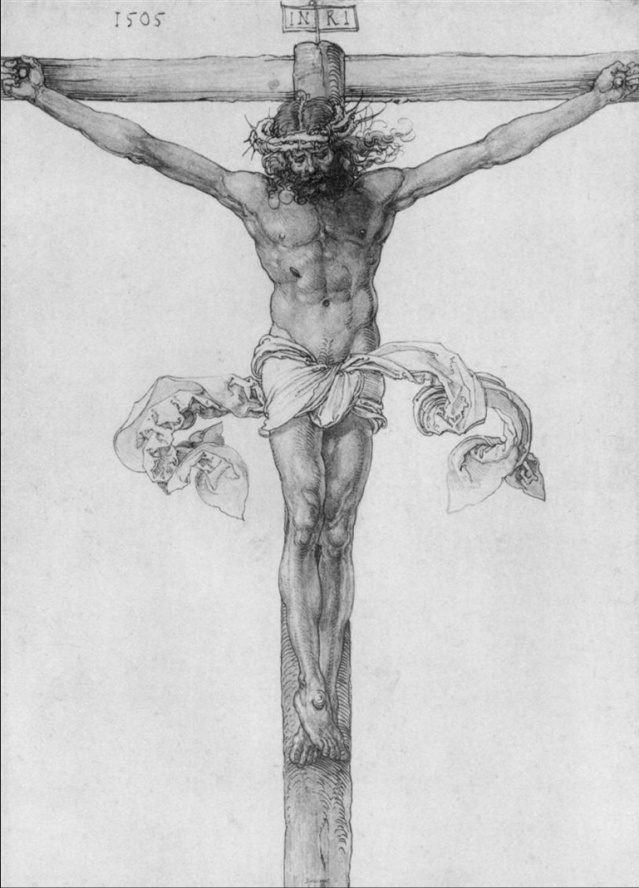
Albrecht Dürer, Christ on the Cross, 1505
Right at the intersection of Heaven and Earth. In Christian terms, the adoption of this burden was seen as the power that turned tragedy into comedy.
In more contemporary terms, humans stand between their virtual and physical worlds (identities). A human that replaces his or her presence and being with an operating system (self) that, in turn, replaces a human re-imaging with a non-human humunculae, like this …
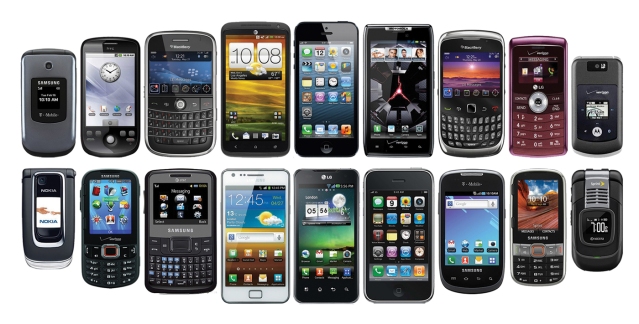
… is, like Goethe’s Faust, making a pact with the Devil (or pure physicality) in exchange for all the (only virtual, not real) knowledge in the world. Abandoning digital technology and its benefits is not the answer, but this is definitely part of the answer:

The alternate is the self-destructing civil war that globalization, individualization and digitalization are trying to prevent but which they cannot bridge. IS has chosen to bait us to destroy the bridges. Experience teaches that we should build more bridges. Some will include cell phones. Many should include the earth, without cell phones. All should be concerned with human power, and what it is and what it is not.





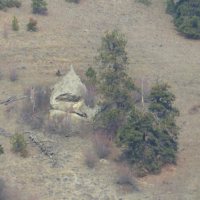








Reblogged this on Where do We go from Here? and commented:
“The alternate is the self-destructing civil war that globalization, individualization and digitalization are trying to prevent but which they cannot bridge…”
LikeLike
Moscow graveyards upgraded to include free Wi-Fi
Imagine standing in a Moscow graveyard late at night. You’re alone, with no bars on your phone and desperately curious about Russian author Anton Chekov…….
http://www.cbc.ca/beta/news/trending/moscow-cemeteries-wi-fi-1.3359681#commentwrapper
Tickles me pink.
LikeLike
Right here in the Okanogan we can do that at Conconully: the graveyard is the only cell service in town. There are even a few plastic lawn chairs among the graves.
LikeLiked by 1 person
Maybe this is the true source of all those zombie twitter accounts.
What a crazy world. Perhaps in the near future we will only have virtual graves….a sims afterlife.
LikeLike
I blame Sesame Street. 😉
LikeLike